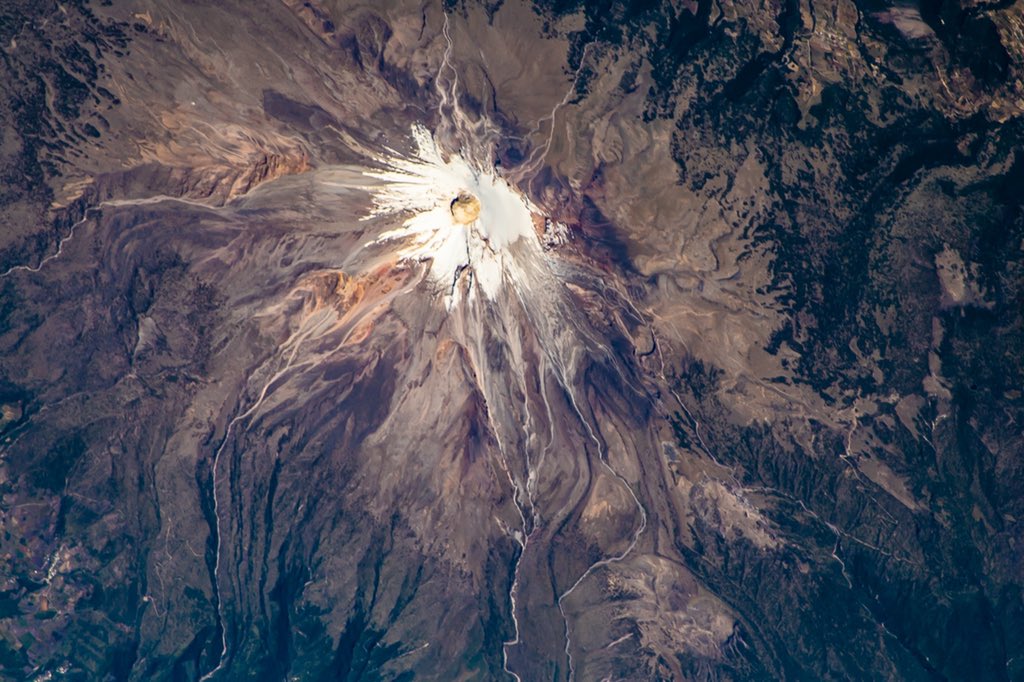[:ja]セルゲイ・リャザンスキー宇宙飛行士がISSから撮影したメキシコのオリサバ山です。

オリサバ山は標高は5,636mで、北アメリカで3番目に高く、メキシコで1番高い山で成層火山です。火山は現在休眠していますが死火山ではなく、19世紀中に最後の噴火を起こしています。オリサバ山はメキシコで氷河を持つ3つの火山のうちの1つで、9つの既知の氷河を持ち、また、グラン・グラシャール・ノルテと呼ばれるメキシコ最大の氷河が存在します。メキシコ湾からの水分を含んだ貿易風が断熱冷却と凝縮することによって、大量の雨が火山の東麓に降り、頻繁に霧や低い雲に覆われます。一方、西麓には半乾燥で温暖な暖かい気温で平均年間降水量が550mmの数カ所の領域(Cfa)があり、主にここで観察されている植生は、若干の高山種を含む草や低木です。
地上の様子はこちらです。

参考文献: Sergey Ryazansky’s Tweet
地球俯瞰画像を見る: LiVEARTH
[Earthview Wonders] No.1079: Mt.Orizaba, Mexico🇲🇽
Astronaut Sergey Ryazansky captured from ISS Mt.Orizaba, Mexico.

Mt. Orizaba or Pico de Orizaba which is 5,636m high is a stratovolcano, the highest mountain in Mexico and the third highest in North America, after Denali of Alaska in the U.S. and and Mt. Logan of Canada. The volcano is currently dormant but not extinct, with the last eruption taking place during the 19th century. Pico de Orizaba is one of only 3 volcanoes in México that continue to support 9 glaciers and is home to the largest glacier in Mexico, Gran Glaciar Norte. Large amounts of precipitation fall on the eastern face of the volcano due to adiabatic cooling and condensation from the trade winds that bring moisture off the Gulf of Mexico, while there are some areas on the western side that experience (Cfa) most of the area is semi-dry with temperate to warm temperatures and an annual precipitation average of 550mm.
The local scenery on the ground is as follows.

Reference: Sergey Ryazansky’s Tweet
See earthview photo gallery: LiVEARTH[:en][Earthview Wonders] No.1079: Mt.Orizaba, Mexico🇲🇽
Astronaut Sergey Ryazansky captured from ISS Mt.Orizaba, Mexico.

Mt. Orizaba or Pico de Orizaba which is 5,636m high is a stratovolcano, the highest mountain in Mexico and the third highest in North America, after Denali of Alaska in the U.S. and and Mt. Logan of Canada. The volcano is currently dormant but not extinct, with the last eruption taking place during the 19th century. Pico de Orizaba is one of only 3 volcanoes in México that continue to support 9 glaciers and is home to the largest glacier in Mexico, Gran Glaciar Norte. Large amounts of precipitation fall on the eastern face of the volcano due to adiabatic cooling and condensation from the trade winds that bring moisture off the Gulf of Mexico, while there are some areas on the western side that experience (Cfa) most of the area is semi-dry with temperate to warm temperatures and an annual precipitation average of 550mm.
The local scenery on the ground is as follows.

Reference: Sergey Ryazansky’s Tweet
See earthview photo gallery: LiVEARTH[:]